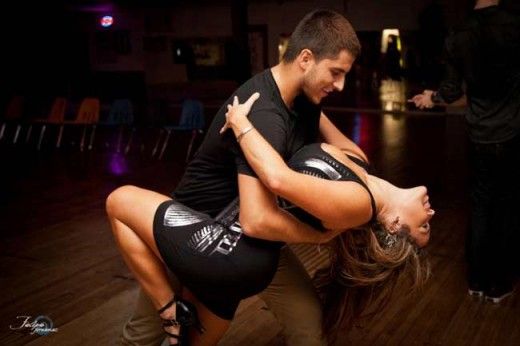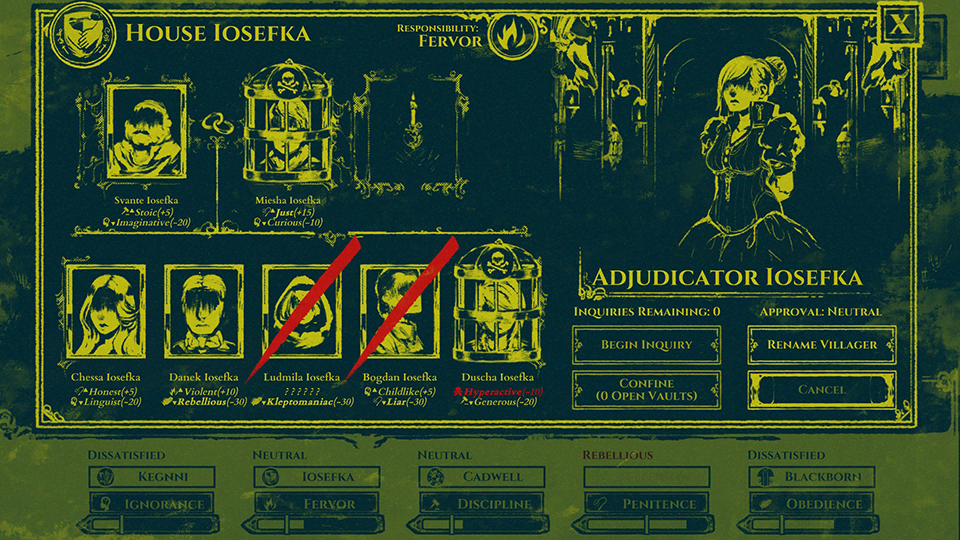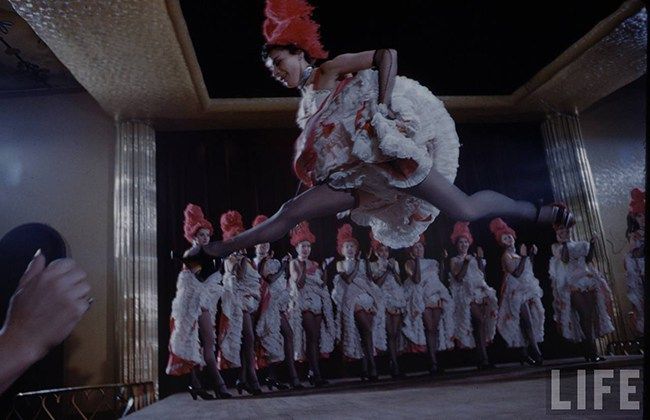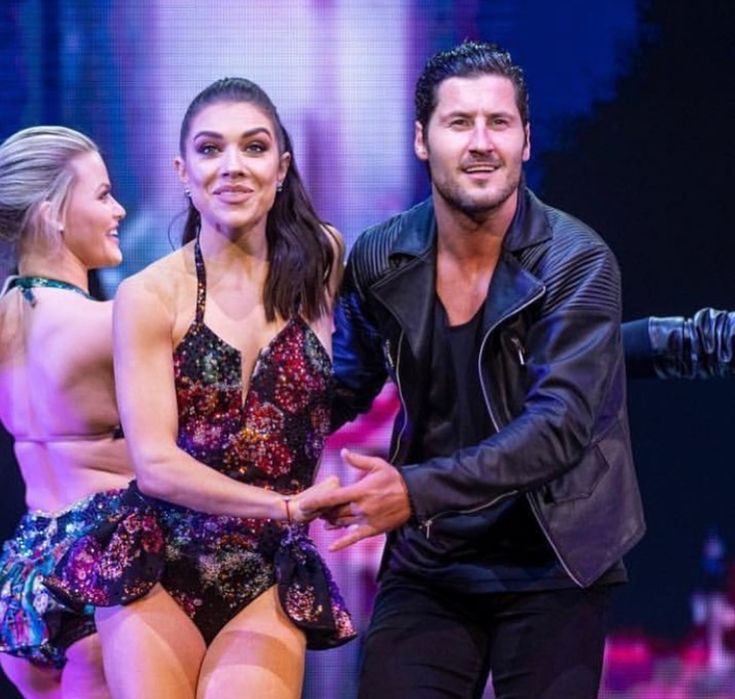How to dance in a mosh pit
How To Mosh: Every Move You Must Know
Call it "thrashing," "slam dancing," or "going HAM" -- it sure doesn't matter what term you use once you've gotten caught in a mosh.
The ultimate physical expression of rock 'n' roll's pure power and energy, moshing has a rich history dating as far back as the late-’70s, derived from punks who'd jump around at shows. Eventually, the speed and aggression of hardcore and thrash metal began to inspire the shoving and slamming we now know -- the honest rage and love of music exuded by bands like Black Flag and Anthrax inspiring crowds to take things in an angry-as-hell direction.
That said, moshing wasn’t always a positive release, and many a Nazi and hardcore gangster used the pit as a place to beat people up, inspiring bands like Black Flag, Circle Jerks, and Fugazi to publicly call people out for moshing at their shows. It seemed like the crisis had come to a very public head in 1996, when Smashing Pumpkins publicly announced they were against moshing after a woman died at one of their performances.
But as fans of punk and metal evolved, so did moshing; these days, the pit is much more of a place to blow off steam and give oneself to the power of the riff than partake in a flailing free-for-all. But in case you’ve never had the pleasure of getting your shit rocked at a Lamb Of God show -- or simply wish to reconfirm what you know -- here’s a move-by-move breakdown of the mosh.
I. BASIC RULES
Before we talk mechanics, let's go over the generally-accepted rules to moshing. Disobey these at your own risk (i.e. do so, and people will think you’re a towering anus).
1) Pick ’em up when they fall – What it says on the label. When someone falls down, you pick ‘em up before doing anything else.
2) Hold lost items over your head – If you find someone’s lost phone, shoe, watch, glasses or wallet on the floor, hold it over your head and walk around or through the pit so they can find it.
3) No punching, choking, or fighting in general – That shit is how cops get called and venues get closed.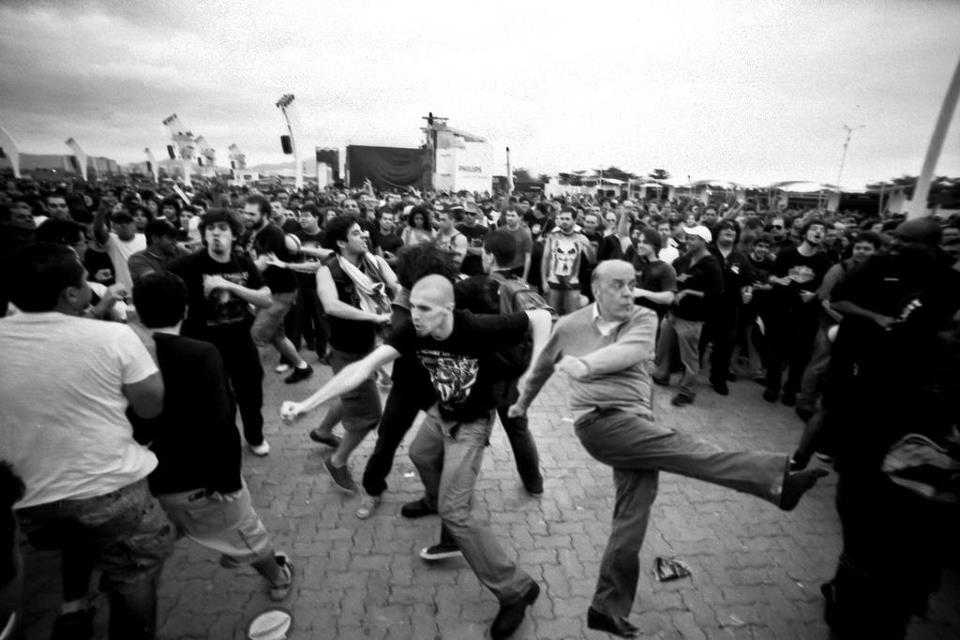 Take it outside, champ.
Take it outside, champ.
3) Don’t shove someone into the pit who doesn’t want to go – Don’t be an asshole. If you want a better line of sight, move.
4) Karate gets what karate gives – Yeah, you can do several spin-kicks and chop your hands all over the place, but don’t get upset when you get slammed by the huge dude who is sick of you.
5) Don’t crowd-kill – Crowd-killing is when you wile out on the people at the edges of the pit to get them involved. Leave the innocent bystanders alone.
6) Nazis, bullies, and gropers are cruising for an abusing – If you’re here to throw the Heil, beat on someone smaller than you, or cop a feel, you’re begging someone to murder you with a crowbar.
7) No whining – Aw, did a crowd surfer accidentally kick you? Did you get accidentally duffed in the face? Sucks -- but guess what? It’s a mosh-pit. There’s a bar in the back to lean on, if you’re not feeling it.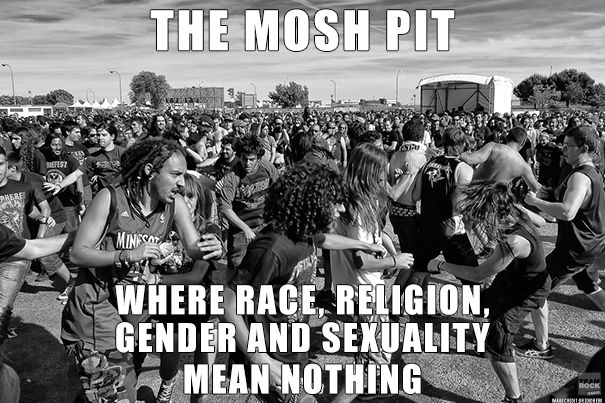
Got it? Great. Let's move on to…
II. MOSH STYLES AND MOVES
Here are the basic styles of moshing, and the moves that come with them.
1) ’BOW-THROWING
Elbow-based moshing. Fun to do, sometimes painful to be around.
1a. Two-Stepping
This is an essential. It’s honestly the perfect move to make before you start doing any serious damage. It’s like running in place, only with ample elbow-throwing as you get into it. What a move, look at it go.
1b. The Lawnmower
An oldie but a goodie that became popular in the early 2000s after emo kids stole it from corny punks. It’s a pretty comical move to make at this point, especially if the point of moshing is trying to look scary. However, it used to be very a cool looking startup to an eventual beatdown.
1c. Picking Up Change
Pick it up pick it up pick it uuuup! This one sort of makes you look silly, but it’s fun to do. Snap your hand down to the ground and then yank your elbow back. Ooh, a penny!
Snap your hand down to the ground and then yank your elbow back. Ooh, a penny!
Next up…
2) EMO KARATE
Mosh moves that emulate combat. Just know you kind of look like Mac from Always Sunny doing these (aaand you might get your ass kicked).
2a. The Hinge
Make a fist and stick it out in front of you. Whip your arm back and forth in a wide arc as though it’s is attached to your shoulder by a hinge. That’s it, that’s the whole move.
2b. Roundhouse
This move is when going to a show becomes the cheapest martial arts class you could ever take. Kick the leg up as far as it goes, and spin in a circle, to make contact with someone who doesn’t see it coming for the life of them. Might get you kicked right the fuck back.
2c. The Windmill
The windmill can be traced back all the way to the early '90s (check out some of those moves in Biohazard's Shades of Grey video from 1992) -- but the move would become much more mainstream with the explosion of early 2000s metalcore/hardcore. When people whirl their arms as fast as they can, there’s no way they can miss. What better way to guarantee a hit than to actually just aim at everything?
When people whirl their arms as fast as they can, there’s no way they can miss. What better way to guarantee a hit than to actually just aim at everything?
Thirsty for more? Because it's time for…
3) HIT AND RUN
The cardio of moshing. Usually a good way to get the whole crowd involved. Smokers beware.
3a. Skanking
The go-to move for ska kids and pop-punks, skanking is like exaggerated walking, or two-stepping with no thrown elbows. Generally peaceful, and a great way to move through a…
3b. The Circle Pit
Ol’ reliable. The fascination of the circle, the wheel, the spiral, has been a driving force for mankind for all of its existence, and the circle-pit has been around since the beginning of pissed-off-dude dancing. Anyway: everyone runs in a circle creating a human whirlpool. To instigate, hold up an extended index finger and spin it over your head. Especially popular at thrash metal shows.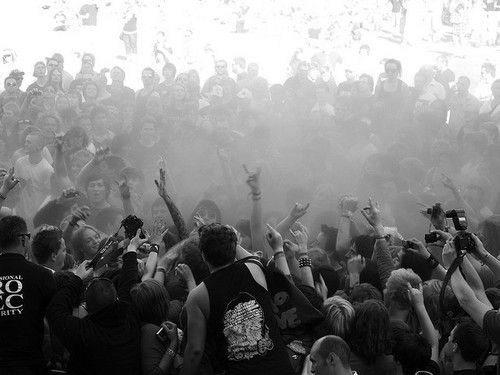
3c. The Wall Of Death
Though this term was originally used to describe when Nazis and assholes at hardcore shows to just mow folks down and trample them, the Wall Of Death has become a much-loved group activity at metal shows. The crowd splits down the middle and pull back, creating an aisle down the middle of the floor. At the singer’s command, the two sides run Braveheart-style at each other and collide in a glorious clash of mosh pittery. Good times, but always remember Rule #1.
***
WORDS: Amanda Van Poznak
A GUIDE TO MOSHING AND MOSH PITS
“Moshing (also known as slam dancing or simply slamming)[1] is a style of dance in which participants push or slam into each other, typically performed to “aggressive” live music. Moshing usually happens in the center of the crowd, generally closer to the stage,[2] in an area called the “pit”. It is intended to be energetic and full of body contact.
”
A guide to moshing. If you’ve been to a rock/metal/ska/sometimes pop/edm concert, you’ve probably witnessed the moshpit. If you’ve lived your life under a rock and have yet to witness a moshpit in real life, you’re still likely familiar with the concept through videos online. Or your mom seeing a news segment on heavy metal concerts and begging you not to get involved with satans music.
Moshing is basically intense dancing with a bunch of other (usually very sweaty and often sticky?) people. It’s a great way to let off some steam, a means to connect further with fellow concert goers and a great addition to a live concert experience. They can definitely be daunting at first, but lots of fun once you get the hang of it.
I debated writing this little guide to moshing at first thinking, well all of this seems really obvious, no? But then I thought back to when I was newbie mosher at fifteen and my friend lost her glasses in a pit. Or the first time I heard a singer yell “WALL OF DEATH” followed by me going “what did he say?” followed by me learning really fucking quick. Shit, this may even end up being a bit of a refresher for whenever the covid pandemic ends and all of us concert goers find ourselves walking back to a festival again as if we were in a coma for a decade and have no idea what year it is.
Shit, this may even end up being a bit of a refresher for whenever the covid pandemic ends and all of us concert goers find ourselves walking back to a festival again as if we were in a coma for a decade and have no idea what year it is.
NUMBER ONE RULE. IF THEY FALL, PICK THEM UP
A bunch of bodies slamming into each other in a small space with loud music and alcohol, you bet there are going to be people on the ground. The biggest difference between a sweet moshpit and a shit one is whether people follow this most important rule. If you see someone fall, YOU HELP THEM BACK UP. 99% of the time your fellow concert goers are great about this, and you’ll see multiple people jump to one’s aid. Pits can get crazy but there’s power in numbers. The few times I’ve slipped and found myself flashing back to my childhood and Mufasa being trampled by wilderbeasts in the Lion King I usually barely touched the ground before several pairs of hands were helping pick me back up. This is what keeps moshpits safe. Well, as safe as slamming bodies can be.
Well, as safe as slamming bodies can be.
NEED TO GET OUT? PUSH OR POINT
If you find yourself way too overwhelmed you just have to push your way out. That may seem overwhelming in itself, but people generally can tell the difference between “yeah this person is totally digging this pit” and “this person wants to get the hell out of here” and will help clear the way for you. If you’re closer to the front, it’s sometimes easier to get some help from security. In this case, it’s often easiest to crowdsurf. “Crowdsurfing?” you may be thinking, “I’m already fucking panicing here!” Trust me, I’ve used this method before to get out of a nasty situation and it can be the an effective escape plan. And if you find yourself needing additional help, you’ll end up literally in the arms of security who can help you.
NO ACTUAL FIGHTING
Moshpits may look violent and dangerous, which they can be, but it’s all fun and games.. until someone loses an eye because some guy looked at some other guys girl the wrong way and he’s pissed and the other guy is pissed that he’s pissed and now they’re trading punches.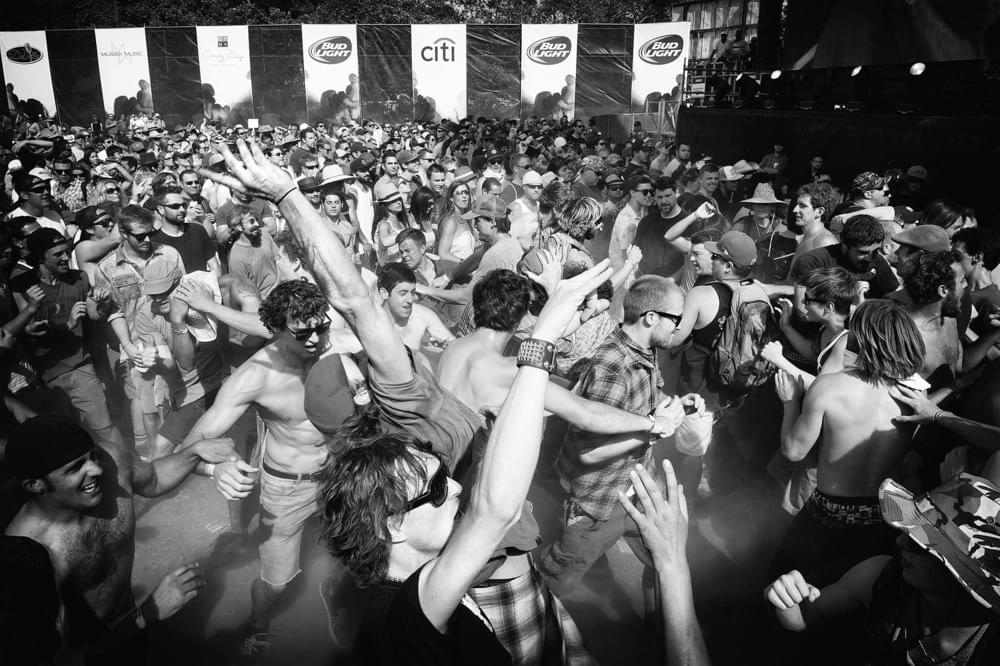 MOSHPITS ARE NOT FOR ACTUAL FIGHTING. You have a problem with someone, get security, or take that shit outside. Don’t ruin it for everyone else.
MOSHPITS ARE NOT FOR ACTUAL FIGHTING. You have a problem with someone, get security, or take that shit outside. Don’t ruin it for everyone else.
DON’T WEAR GLASSES
Cause you’ll find yourself without them about .5 seconds into the first song. Just wear contacts.
BIG JEWELRY? GIANT PURSE? HOOPS EARRINGS?
NOPE. NOPE. NOPE. That cool long necklace will choke you, that giant purse dragged in opposite directions from your body and those earrings? You like that hole being completely surrounded by flesh? Exactly.
TIE YOUR SHOES
Even if you think they should be fine, they probably aren’t. Retie them. Double tie them. Keep those laces tucked in. Losing a shoe in the pit fucking sucks. You may get it back right away or you may find yourself stranded getting your toes stomped on and by some big dude wearing steeled toed boots.
IF YOU FIND A SHOE, OR A PURSE, OR A PHONE, HOLD IT UP
Give people the best possible chance of finding the phone they dropped while trying to take a picture for the gram.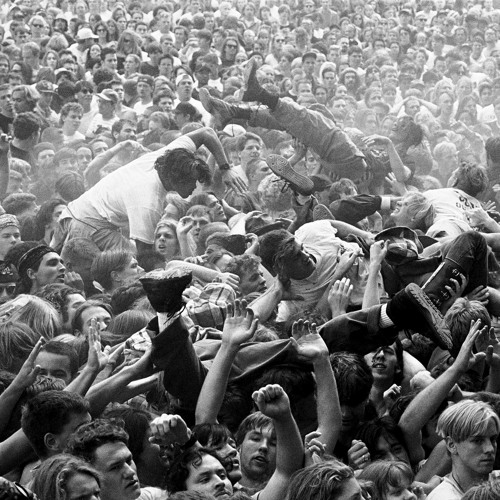 Save someone’s night. Be the change you want to see in the world.
Save someone’s night. Be the change you want to see in the world.
DON’T GROPE/BEWARE OF GROPERS
Most people aren’t shitheads from my experience, but every moshpit seems to have one. And sometimes that shithead is an extra piece of shit who decides to feel chicks up while in the pit. This has only happened to me once but now I can’t even listen to that band I was seeing without thinking of the experience. Yes there’s bodily liquids being shared and tons of skin against skin but do not take that to shithead levels. And beware that others may decide to do so. Use those elbows ladies.
LIMIT YOUR CROWD SURFS
Crowd surfing is fucking fun. I mean it’s terrifying and technically you’re being felt up by a bunch of strangers and hoping they don’t drop you. But jeez, it’s fun. You know what’s not fun? Getting kicked in the head twenty times by the same dude who won’t STOP crowd surfing. Go for a ride once or twice and then keep those feet on the ground for everyone please.
HOW DO I CROWDSURF?
I don’t crowdsurf very often but once in a while it’s fun to go for a ride and it’s easy to do. Look for a couple of bigger people, tap one on the shoulder, smile politely, point up and off you go! Usually the person/people will form a foothold for you to step up and then you’re sort of tossed like a dwarf (cheeky little Lord of the Rings reference there). For all the women reading this, try your best to travel on your back or a whole lot of people will be feeling up your chest. Don’t worry so much about landing the surf, if you end up naturally moving towards the front security will pull you down upon arrival at the barricade. Otherwise you’ll find yourself being lowered by the crowd.
FINISH YOUR DRINK FIRST
Seems like every concert I go to right when the pit starts moving a full beer goes flying over the crowd. Moshing while sticky with beer is unpleasant. Don’t bring your drinks into the pit, unless it’s water. Spray that around all you want, especially if it’s an outdoor summer festival.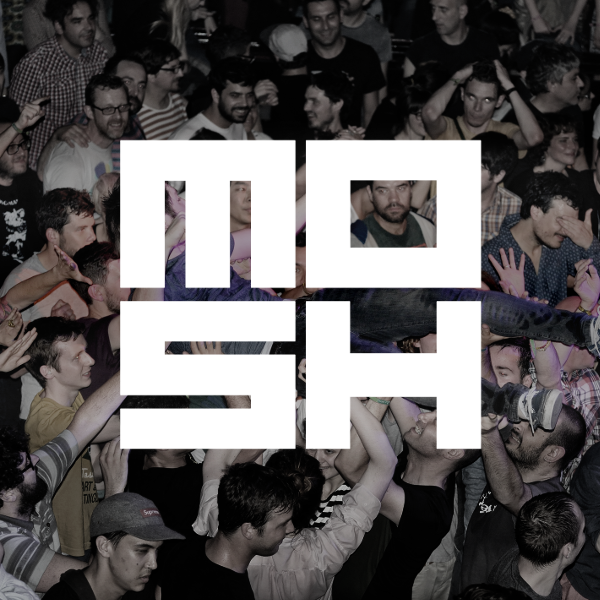 You’ll be the hero in that situation. Otherwise, no drinks.
You’ll be the hero in that situation. Otherwise, no drinks.
WALL OF DEATHS AND CIRCLE PITS
So for the most part moshing is all pretty similar. Sure, you may have the hardcore kids windmilling (swinging their arms like a windmill) or ska kids skanking (not sure how to explain that one, that’s what Google is for) but generally it’s just a lot of pushing and shoving. The two big exceptions that you might want to be aware of as a newbie, are the wall of death and circle pits. These are typically started by the vocalist of the band so you’ll have a bit of a warning one is coming.
WALL OF DEATH. The moshpit splits right down the middle and those on either side of that line push back as far as they can creating a big empty void. Well, mostly empty, there’s usually one of two dudes strutting in the middle thinking they’re either tough or hilarious when they’re neither. At the vocalists command, or the start/obvious intense part of a song, both sides go running at each other and yeah.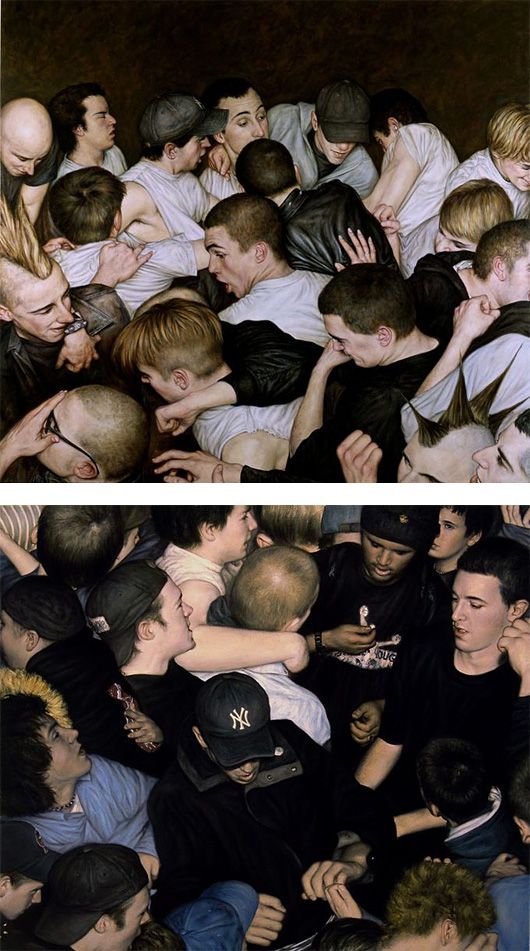 Wall of death. I don’t like these and when I hear wall of death I go barging my way out of the battle field as quickly as I can. Cool to watch though.
Wall of death. I don’t like these and when I hear wall of death I go barging my way out of the battle field as quickly as I can. Cool to watch though.
CIRCLE PIT. Is a mosh pit. In a circle. Running and shoving in a circular motion. A circular pit. You get it. I also don’t really like these, it’s just a lot of running. Exception, the linked arm polka style pit I was in at a Gogol Bordello concert on a beach. That was fucking fantastic.
Be warned that there tends to be a LOT of falling during circle pits.
Alright, this is making me feel pretty nostalgic for the days when the thought of rubbing up against a bunch of strangers wasn’t completely frightening, so I’m going to end this here. There’s definitely more to learn if it so tickles your fancy. Like the various “moves” and differences between a ska pit and a death metal one. Or how to properly hold up a singer who decided they wanted an epic conclusion by balancing on peoples hands while belting out a chorus.
But overall I think this guide to moshing is a pretty good overview or what to expect and how to approach the mosh pit . . Whenever those are a thing again. If you find yourself immediately post covid at one of the first metal shows happening, and are new to this world of moshing and want to give it a go, I applaud you. But I also warn you. After a year or two or however long the wait ends up being, the first few moshpits are going to be WILD.
. Whenever those are a thing again. If you find yourself immediately post covid at one of the first metal shows happening, and are new to this world of moshing and want to give it a go, I applaud you. But I also warn you. After a year or two or however long the wait ends up being, the first few moshpits are going to be WILD.
I can’t fucking wait.
Mosh - frwiki.wiki
For the article with the homophone name, see Moche.
Not to be confused with Mohs or OBC.
For the articles of the same name, see Mosh (disambiguation).
Mosh during The Dillinger Escape Plan concert.
Mosh is a type of dance violent medium of punk, hardcore punk and metal since the 1980s. Borrowed from pogo, which was practiced by British punks around 1976, various codified additions were added to it in metal mechanisms 1980s to become mosh. Moving the arms back and forth (some movements are choreographed), throwing the legs back and forth (a bit like a martial art), sometimes touching the ground with the hands in rhythm to the music, pushing each other on punk, metal, and especially hardcore music (note that in French the term "pogo" is preferred for punk and metal).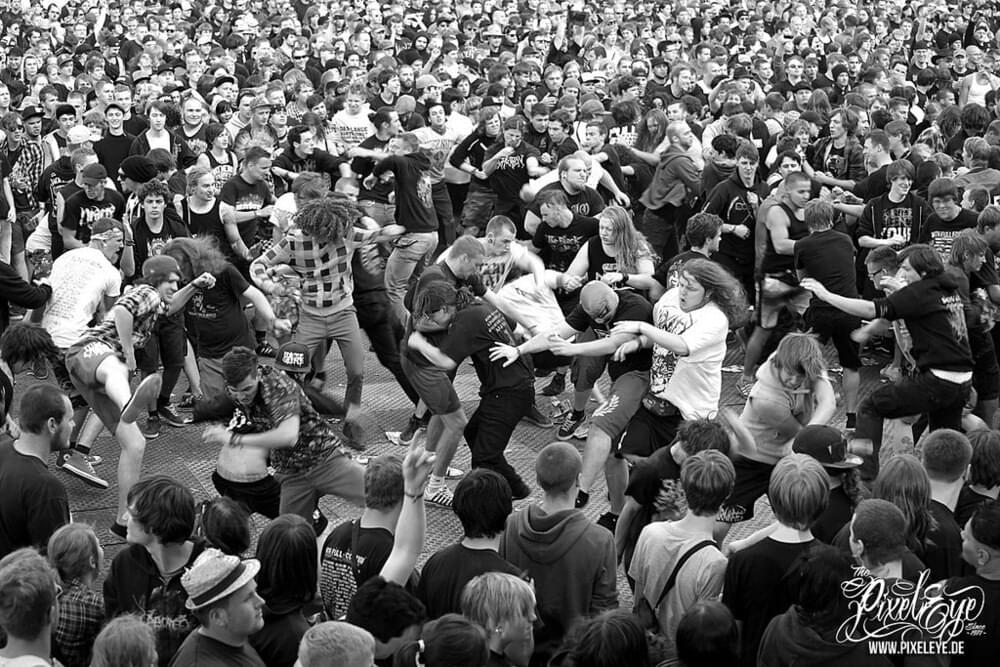 Mosh is popular at concerts.
Mosh is popular at concerts.
Mosh is usually practiced in the area called mosh-pit or circular pit . Initially, mosh dancing was usually done by people right next to the stage. It is now common to see mosh pit circles scattered throughout the auditorium or including the entire auditorium.
Summary
- 1 Origin and history
- 1.1 Origin
- 1.2 History of
- 1.3 In France
- 2 Description
- 2.1 Some movements
- 3 types of moshing
- 4 References to mosh in culture
- 5 Risks and criticisms
- 6 Links
- 7 External links
Origin and History
Origin
Vinny Stigma of the hardcore band Agnostic Front is "mosh" as an acronym for "March Of Skinheads", but many credit him to also Darryl Jenifer, bassist for Bad Brains, due to his Jamaican the pronunciation of the word "mush" in the word "puree Babylon".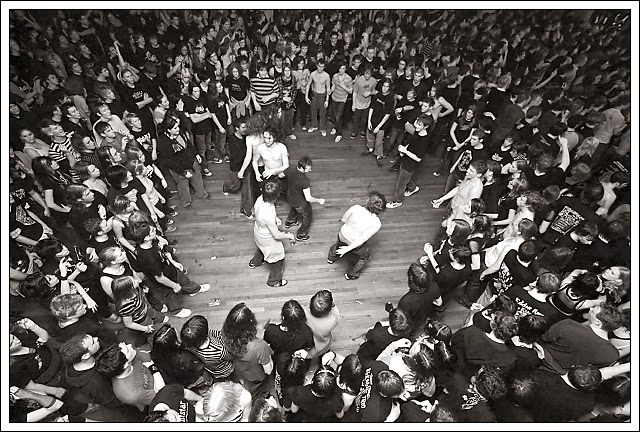 Lots of first wave punks in talking scenes more pogo (and in America thresh ), while the term slam seems to have gained a lot of notoriety especially when the hardcore and metal scene started to grow. Mix and influence each other.
Lots of first wave punks in talking scenes more pogo (and in America thresh ), while the term slam seems to have gained a lot of notoriety especially when the hardcore and metal scene started to grow. Mix and influence each other.
History
Mosh pits appeared no later than 1981 at a number of punk concerts, then it was called pogo. This type of dance then spread to the heavy metal scene, where head banging and slamming were later added. By mid 19In the 80s, when thrash metal bands such as Slayer, Metallica, Megadeth and Anthrax were still playing in clubs, mosh pits were already a common sight during punk concerts. And at the giant Woodstock festival in 1999, moshing turned into real riots. To address the problems caused by this phenomenon, concert halls, accustomed to hosting groups that can cause mosh pits, are beefing up their security personnel to control the audience, in particular the "T-barricades" that divide the pit in two, and "are also moving ".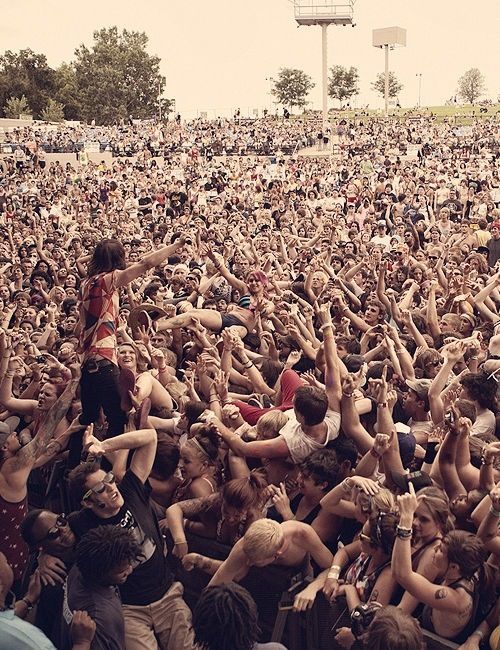 away from the group.
away from the group.
Nirvana's music video for "Smells Like Teen Spirit" launched mosh pit into the mainstream in 1991. In the video for The Leaving Song Part II from A Fire Inside and the video for the song Wake The Dead by hardcore band Comeback Kid, a mosh pit for about 100 people is presented. Mosh also originally matched a break in the song's rhythm, most often marked by slowness and heaviness, announcing the explosive ending. The given children's comeback song is an example.
B , The Smashing Pumpkins play a show at the Point Depot in Dublin. The crowd that comes to watch them is very large, and despite repeated calls for calm by the group, who ask the crowd to stop the mosh pit, a 17-year-old fan, Bernadette O'Brien, is killed - crushed and trampled. The concert ended quickly and the following evening concerts planned in Belfast were canceled out of respect for her. Billy Corgan, lead singer of the Smashing Pumpkins, would later state that he left the band and show business almost forever after the tragic event.
In France
In France mosh pit is less common than other forms of extreme hardcore dance such as pogo. However, in some scenes it really worked out well with the addition of screamo and hardcore moves. The success of the Clisson Hellfest is proof of this, such as the giant mosh at the Dagoba concert filmed during the 2014 release. This phenomenon is similar in scale to scenes seen in the United States.
Description
Dancing has always been a central part of the punk concert atmosphere. Reflecting the punk state of mind, punk dances initially have no rules and consist of moving frantically in all directions to the sound of fast beats, not hesitating to push your neighbor from time to time.
Hardcore concerts, because of the importance of the meaning of the words and the often stronger musical rhythm associated with the often reduced scale of the concerts, have witnessed the emergence of new forms of dance: dance rhythm in jerks, combination of hands and feet. and head movements, punches and kicks, chasing steps and drums. The dance is performed to the rhythm of the music and the different styles do not allow the same styles of mosh to be used. The dance is performed in an empty place in the middle of a crowd of spectators, called a "pit". The "pit" can be larger or smaller, depending on the size of the hall, the number of dancers, and the overall size of the audience. Mosh is an individual dance, although some figures can be performed collectively. Since 2010/2011 we have seen the emergence of groups of pit dancers such as the masked Mexicans from "el lucha core libre".
and head movements, punches and kicks, chasing steps and drums. The dance is performed to the rhythm of the music and the different styles do not allow the same styles of mosh to be used. The dance is performed in an empty place in the middle of a crowd of spectators, called a "pit". The "pit" can be larger or smaller, depending on the size of the hall, the number of dancers, and the overall size of the audience. Mosh is an individual dance, although some figures can be performed collectively. Since 2010/2011 we have seen the emergence of groups of pit dancers such as the masked Mexicans from "el lucha core libre".
Some movements
Mosh is not a theoretical dance, but we can describe a number of movements with an agreed name:
- hitting from the floor or picking up, altering or beating: consists in pretending to hit the ground with his fists, while leaning, advancing in the middle of the pit with small jumps or not;
- "circular moshing" or circular pit is specially used for fast tempos: a group of dancers running or "moshing" form a large circle around the pit in an attempt to attract non-dancing spectators;
- two step dance from old school hardcore .
 It consists of a dance step in which one foot passes in front of the other, the latter is removed to move it back forward, and so on, which may be accompanied by arm movement (pinwheel, swing from left to right, etc.). It should be punctuated by music;
It consists of a dance step in which one foot passes in front of the other, the latter is removed to move it back forward, and so on, which may be accompanied by arm movement (pinwheel, swing from left to right, etc.). It should be punctuated by music; - windmill: it is to make a coil with two hands very quickly. This is often the source of minor incidents as it is of a very violent nature;
- from side to side: it consists of running from left to right, pushing other spectators to increase the pit in front of the mosh;
- kick-moshing: consists of performing as many kicks and punches as possible in empty space for the entire length of the piece. A very violent style of mosh, it is often performed in Hard-Core bands because the performance is very violent and therefore dangerous;
- Gorilla stomp: consists of bending over and punching the ground while being beaten.
Types of moshing
Moshing is a generic term for any dance performed in a mosh pit or circular pit.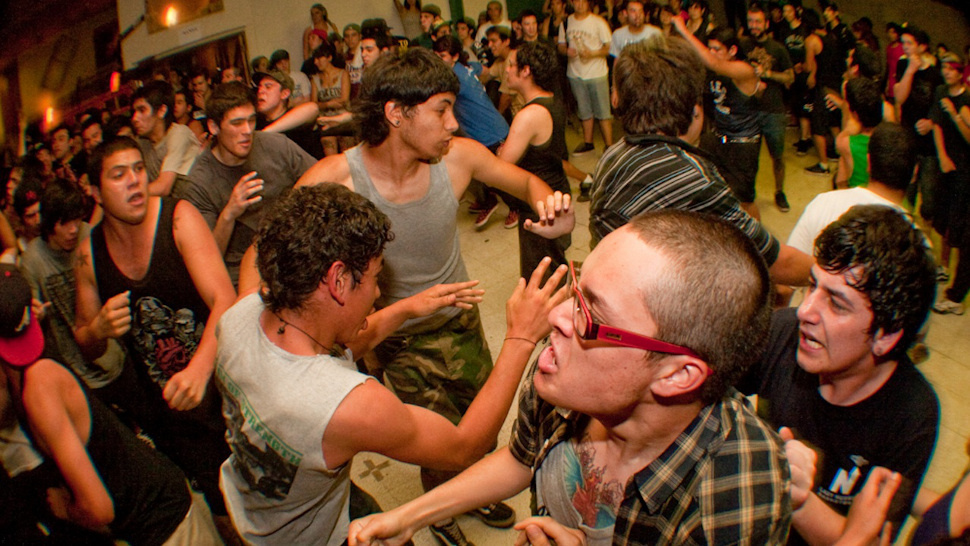 However, some movements are more in line with certain passages of music.
However, some movements are more in line with certain passages of music.
Moshing, sometimes called pogo, means different things depending on the music it is used for.
- Breakcore, a kind of hardcore techno that brings in a lot of former punk and former metalheads and thus their mosh pit.
- Grindcore is also his dance style, which is often referred to as grinding and a cross between skanking (see below) and slower mosh.
- Metal concerts are known for their gigantic epaulettes, fueled by the popularity of the genre and hence the large capacity of concert halls. Due to the rapidity of the metal tempo, the speed of the dance movements themselves increases. Also known as Speed mosh, this maddened pogo is often performed during concerts by bands such as Iced Earth and Megadeth. The faster the metalhead moves, the crazier and more uncontrollable the mosh becomes. Speed mosh is called trash in Quebec, and the term "mosh" is commonly used to mean "hard".
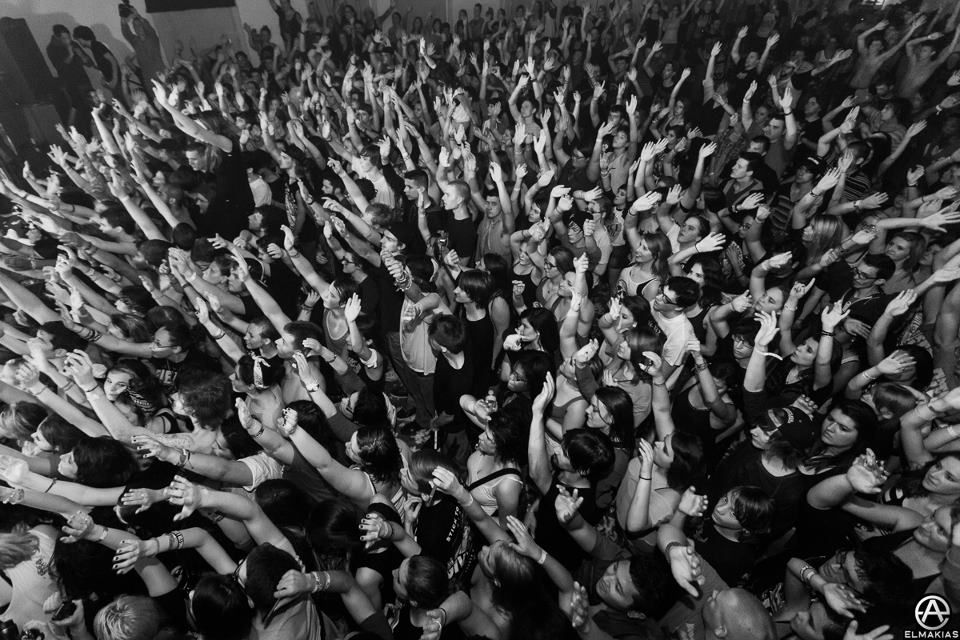
- Punk mosh or pogo usually includes big waves when everyone pushes each other, throws themselves at each other, kicks when the crowd carries one or more people, and straight pogo: jumping while pushing each other (an invention attributed to Sid Vicious from The Sex Pistols). Mosh at punk concerts is generally less violent and theatrical than mosh and pogo at hardcore concerts.
- Mosh practiced during hardcore concerts is much faster. Hardcore mosh is often characterized by very fast and jerky hand and foot movements that are very frowned upon outside of the specific context of hardcore.
Mosh references in culture
- The band Ultra Vomit parodied the song for flirting by Delpeche in a hardcore metal version but singing "for mosh". The song is the eighth on the album Objectif: Thunes .
Risks and Critics
While most moshers find moshing fun, amusing and enjoyable, there is always the risk of minor or even serious injury.
Moshing advocates acknowledge that dancing is associated with physical risk. But they also argue that pogo and mosh create social bonds such as friendship and camaraderie, and finally, serious (sometimes, unfortunately, fatal) injuries are caused by blows: that's a completely different thing.
But those who criticize moshing also accuse pogo of inciting violence and the relativity of these facts. Violence among the population inevitably leads to injury. Critics of moshing explain that we can see an escalation of violence, a vicious cycle that moshing breeds. The media encourages this interpretation.
Moshpit is an extreme sport for many. Many people truly believe that mosh pit stimulates and encourages communication. While mosh is supposed to be a dance where people don't interact, where no hitting is allowed (unlike pogo in the punk scene), accidents do happen, however, usually caused by people thinking mosh is a violent dance . An escalation of violence often occurs when someone not used to mosh pits or standing outside of them gets hit. It must be remembered that the mosh pit is intended for entertainment.
In fact, there is some kind of confusion between the real danger of the pit and the behavior of the mosher.
Definitely a risk for moshers or those who get too close to the pit. Many mosh pit supporters believe that one of the interests of mosh pit is its physical nature, and that its risks can be compared to those of any extreme sport. Some even suggest that mosh fulfills a certain desire to inflict pain and physically challenge oneself, as a kind of stress and pressure relief.
It has been argued that moshing is a kind of modern "rite of passage" where young people test their courage and strength with their friends or complete strangers in an unpredictable situation of violent and frantic dancing.
Recommendations
- ↑ Arte TV channel has been filming Hellfest concerts since 2012. Dagoba since 2014.
External links
- (en) Website of Joe Ambrose, Author of Moshpit Culture
- (en) Imosh.
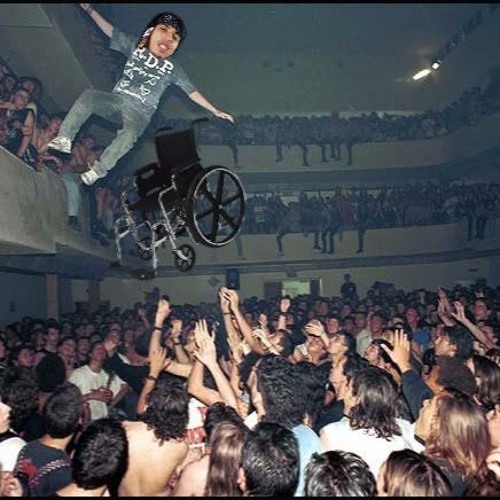 com - Heavy metal goods since 1986.
com - Heavy metal goods since 1986. - Danforth 3D clip of hardcore and violent dance scene
Dancing with tambourines: unexpected meanings of dances from different peoples and eras
How to approach the inaccessible target? Is it possible, using dance steps, to cultivate a feeling loyalty? And how many people know that mosh movements in heavy metal culture categorically reject the manifestation on site of hooliganism and signs of Nazism? Ancient Armenian dances, baroque steps, plasticity of sadness of the Art Nouveau era became the subject of discussion at the round table, organized by the Institute for Humanitarian Historical and Theoretical Research (IGITI) them. A.V. Poletaeva HSE.
Topic of the round table — "Dances of Joy and Sorrow: Emotional Modes in Dance, from Antiquity to modernity”, the event was dedicated to International day of dance.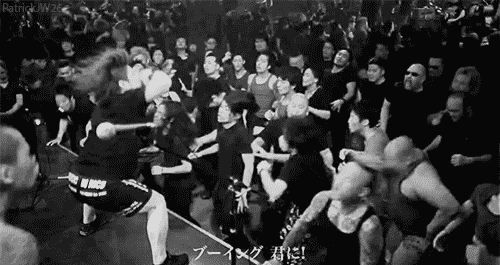
Ballet master and tutor State Song and Dance Ensemble "Orovel" of Armenia Manvel Alevoryan, speaking with the message “Traditional wedding dances of Armenians”, spoke about ancient wedding ceremony. It began at dawn with a cry - a special melody for the zurna associated with the pagan worship of the sunrise. Slow ritual dances symbolized the veneration of ancestors, the participants moved to the right, because the right side was considered lucky.
Ritual began with the dance “Mother of the Crowned, Come Out,” during which the groom’s friends they sang a song, the meaning of which was to enumerate the duties of the bride. Then mother groom went to the center of the circle, showered her son and daughter-in-law with sweets, dried fruits, raisins, nuts and coins, kissed her son and daughter-in-law in the eyes.
Also guests weddings participated in amulets dances to protect against evil spirits. One of them there was a road dance in which everyone could participate, regardless of social status.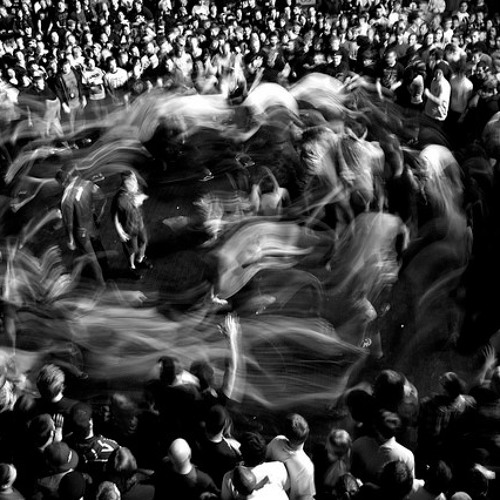 The dance was led by leaders who often changed direction and led the string along a winding road. In their hands were colored handkerchiefs, and in at night - torches to illuminate the road and cleanse it from evil spirits. The tradition has been preserved: any procession must return by a road that differs from the one by which they left the house to confuse evil spirits.
The dance was led by leaders who often changed direction and led the string along a winding road. In their hands were colored handkerchiefs, and in at night - torches to illuminate the road and cleanse it from evil spirits. The tradition has been preserved: any procession must return by a road that differs from the one by which they left the house to confuse evil spirits.
Manvel Alevoryan spoke about a unique custom - the dance of the groom on the burial stone deceased father, if he died before the marriage of his son. It may seem to some blasphemy, but the custom survived. It begins with the consecration of the grave by the priest, after which the groom performs dance steps, symbolizing a dialogue with his father, notifies him of a joyful event in the life of his son. With his dance he asked paternal blessing and swore allegiance to the family hearth. During ceremonies were also performed by martial dances, showing the strength and dexterity of the groom, they used sabers, swords, such dances are characterized by sharp movements.
Anastasia Zolotukhina, researcher at IGITI, researcher and practitioner of the European baroque dance, introduced the audience to the message “Harmony and disharmony effects in the stage. Belle dance is a more accurate name for baroque dance. mid-seventeenth to mid-eighteenth centuries, she explained. It dates back to 1661, when King Louis XIV founded the academy of dance, opposing it to war and internal unrest. The dance, according to the plan of the king, was to symbolize peace and educate loyal subjects, improve their bodily structure and souls. His task was to harmonize and appease the French, to prepare the best people for the state.
Photo: frame from the film Le Roi danse / pinterest.ru
Artistic the purpose of the dance was to reflect the signs and movements of the body of secret feelings souls. The king believed that with the help of learned movements, figures and eloquent dance techniques allow the dumb to speak and tell stories. Ballet and theater of that time were conceived as the heirs of the ancient theater, the main genre of which was a tragedy.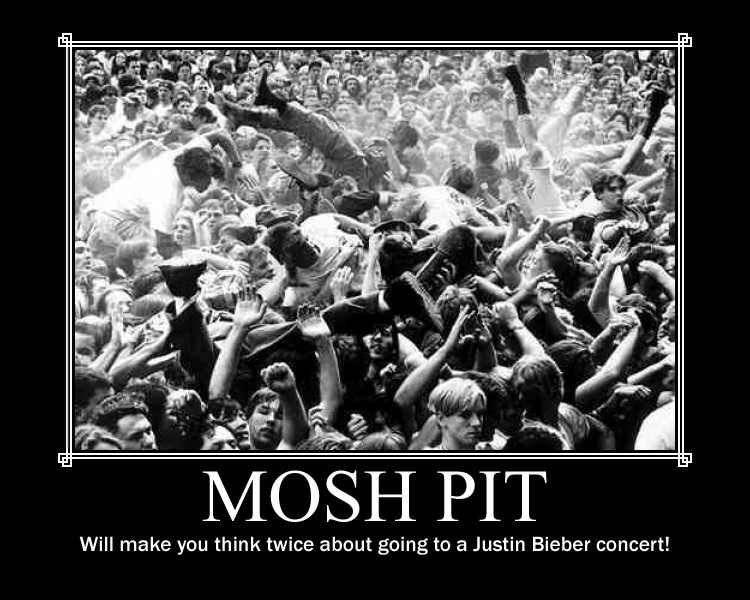 Many playwrights, directors and actors believed that the brighter the effects shown to the viewer, the stronger will be the emotional impact. For this, said Anastasia Zolotukhina, the authors and directors alternated contrasting affects so that a person, having experienced fear, easily passes to jubilation. This explains the penchant of the theater of the time for a happy ending, so as not to leave the viewer in an unhappy mood.
Many playwrights, directors and actors believed that the brighter the effects shown to the viewer, the stronger will be the emotional impact. For this, said Anastasia Zolotukhina, the authors and directors alternated contrasting affects so that a person, having experienced fear, easily passes to jubilation. This explains the penchant of the theater of the time for a happy ending, so as not to leave the viewer in an unhappy mood.
One of dance theorists, Claude-Francois Menestrier, in the book "On Ballets Ancient and Modern" described the three components of the dance of his era: steps or body movements, figures (movements in space) and the expressive part. He considered ballet dumb poetry reflecting the passions and affects of the soul. The most important gestures and expression faces. According to Menestrier, anger can be expressed in violent movements, quick and swift steps falling out of rhythm, burning glances. sadness was reflected by uncertain movements, trembling, downward gaze, entwined hands.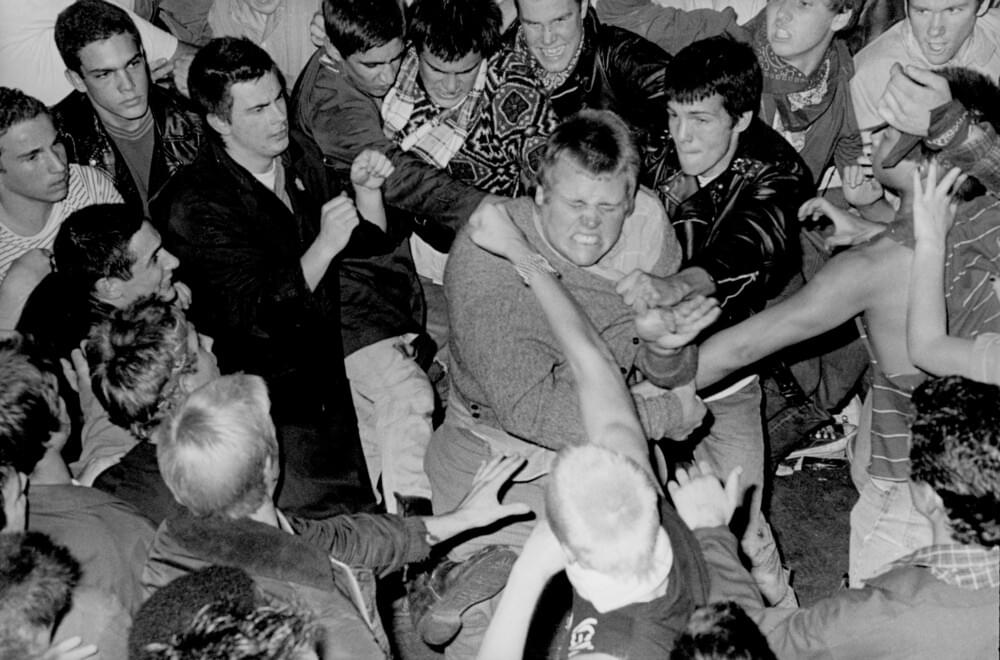
Movement Culture Researcher, Leading Research Fellow Institute of the History of Natural Science and Technology of the Russian Academy of Sciences Irina Sirotkina spoke about characteristics of modern dance. Dance often allows the performer to experience emotions that he does not experience or rarely experiences in life. Dance of the era Art Nouveau often expresses sadness. For example, one of the most famous representatives, Isadora Duncan, after the death of her children in 1913 returned to the profession, performing a dance to the funeral march of Frederic Chopin, which looked more like a pantomime than the usual dance steps: it has a lot gestures designed to enhance the impression of music. Duncan and the modern dancers created a stereo effect from a combination of music and movements.
Isadora Duncan, photo: Wikimedia Commons
Another prominent figure in modern dance, Mary Wigman, staged the dance Exodus (“Exodus”), in which the dancers make movements, symbolizing search, wandering blindly, being lost. Such works were characteristic of the interwar period.
Such works were characteristic of the interwar period.
Russian modern dance was expressionistic, with a deep emotional content and different affects. For example, Kasyan Goleizovsky, who worked on the verge of ballet and pantomime, at one time introduced the dance "Sage", a bright male solo. And the choreographer Lyudmila Alekseeva at the height of the revolution staged a trilogy with heroism, the themes of death and commemoration of the fallen.
Modern researchers of Russian modern dance are trying to restore the aesthetics of the Heptahor studio, founded in 1918 by a fan Greek culture by Thaddeus Zelinsky. She was characterized by a desire emphasize the expression of music with physical movement, unusual plasticity. IGITI senior researcher Alexandra Kolesnik presented the message "Moshpit: Emotion and Affect in Heavy Metal Culture". In her opinion, "moshpit", or "mush", looks like a physical response and the embodiment of aggressive music, verbalized indirectly through the description of the war and the praise of weapons.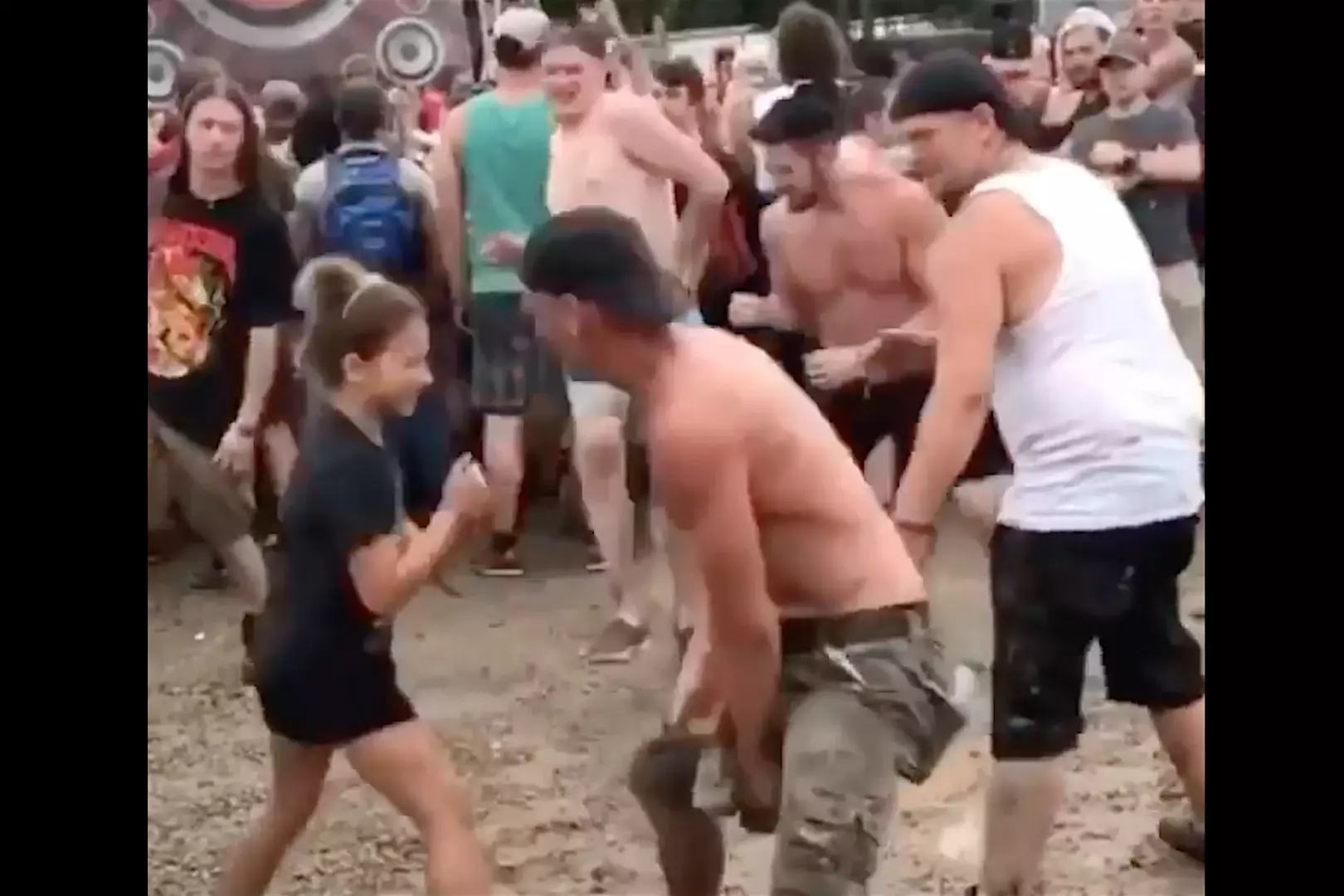
Heavy metal music appeared at the turn of the 1970s-1980s, it was a working-class, often underground culture, quickly gaining popularity in regions and cities that are facing a crisis deindustrialization. Unlike punk rock, the protest turned out to be hidden and forced into the zone of the irrational through military and mythological subjects. Then the adaptation of the dance, which appeared in another culture, to heavy metal also took place. Moshpit is a combination of the words "mush" and "funnel", it resembles a whirlpool, reflecting the space of the dance. Moshpit is a fierce form of dance reflecting aggression and a collective expression of emotions,” said Alexandra Kolesnik. She identified several key elements of the dance. Skanking- simultaneous raising of the right arm and left leg, imitation of movement on the spot, very fast, but not touching others; mosh - imitation of a fight and waving fists with shouting out inarticulate sounds (in this element, the speaker noted, imitation is important, which distinguishes dance from real fights). Stage diving involves performers jumping into the crowd, it continues crowd surfing, when a musician is handed over for as long as possible. Then center slam - several people do not participate in the cycle, but simply stand still and move to the beat of the music. Finally, at the wall of death, the hall is divided into two parts and simulates a wall-to-wall collision.
Stage diving involves performers jumping into the crowd, it continues crowd surfing, when a musician is handed over for as long as possible. Then center slam - several people do not participate in the cycle, but simply stand still and move to the beat of the music. Finally, at the wall of death, the hall is divided into two parts and simulates a wall-to-wall collision.
Mosh pit has clear rules that are constantly repeated on fan forums and are indicated on concert tickets. The attention of the participants despite the outwardly aggressive nature of the dance, it refers to caring for one's neighbor: those involved in the mosh pit are required to support the weak and lift the fallen, Ask for help when the person is unable to provide it. It is emphasized: if the aggressor wants to throw out negative emotions through a fight, he has no place on moshpit, he is expelled from the circle and handed over to the organizers of the concert. Not on site places to Nazis and hooligans, its use for propaganda is considered non-compliance with etiquette.

